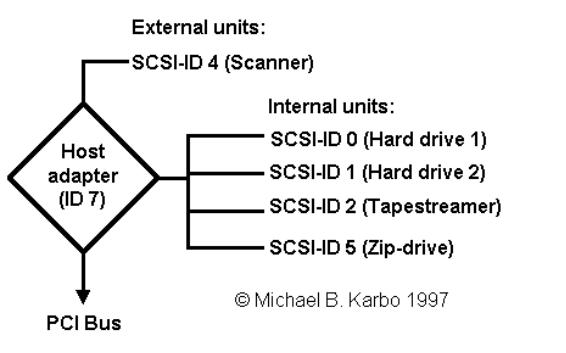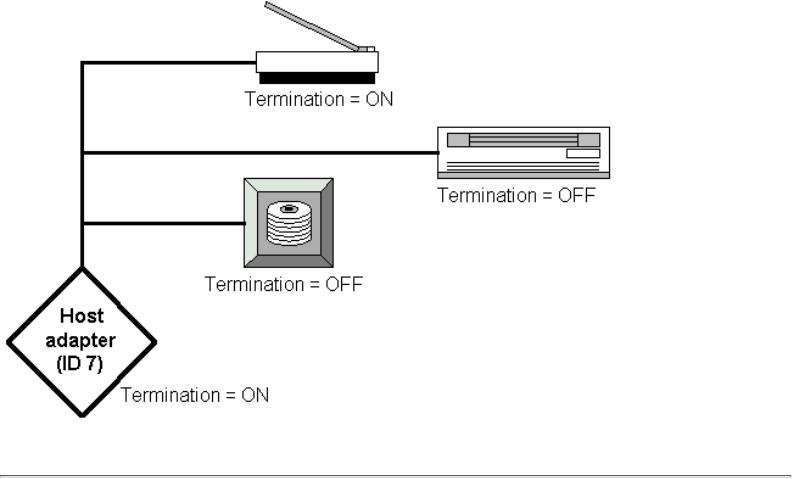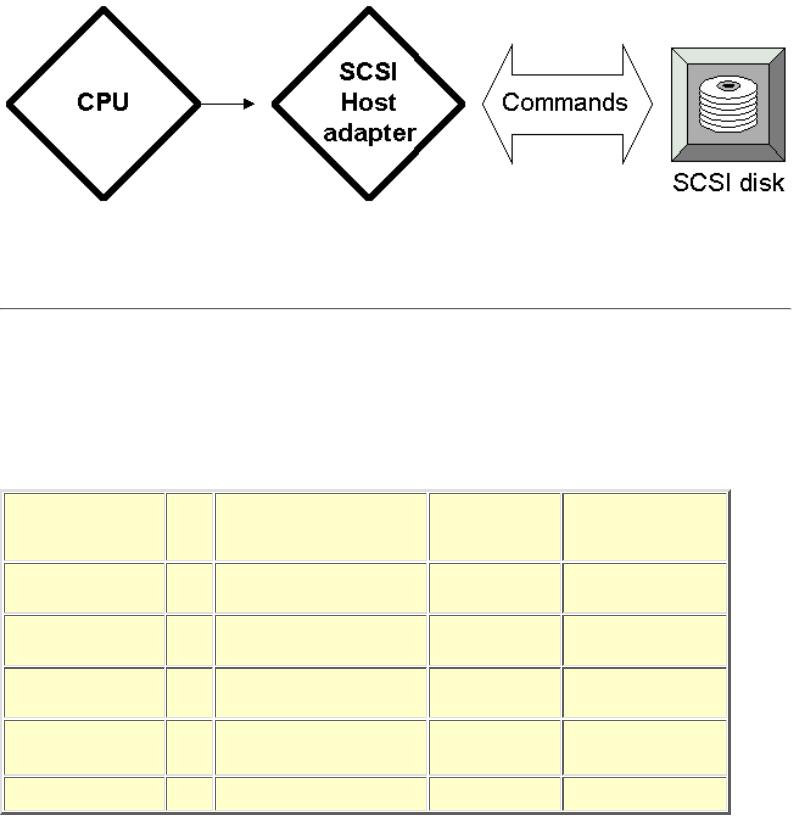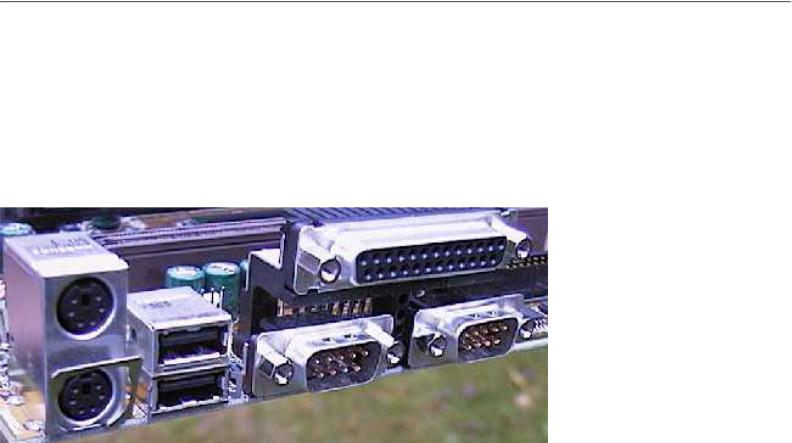
- •A complete illustrated Guide to the PC Hardware
- •Click & Learn. Module 1a. About data.
- •omdata2
- •An illustrated Guide to Motherboards
- •An illustrated Guide to the PC System BUS
- •An illustrated Guide to I/O-busses
- •An illustrated Guide to Chipsets
- •An illustrated Guide to RAM.
- •An illustrated Guide to CPU's from 8086 to Pentium-II
- •An illustrated Guide to CPU improvements
- •An illustrated Guide to Pentiums
- •An illustrated Guide to Over-clocking.
- •An illustrated Guide to disk drives - storage medias.
- •An illustrated Guide to harddrives
- •An illustrated Guide to optical drives (CD-ROM's, DVD's)
- •An illustrated Guide to Magneto-Optical drives.
- •An illustrated Guide to tapestreamers..
- •A Guide to Adapters and I/O units.
- •An easy-read and illustrated Guide to the EIDE, Ultra DMA and AGP interfaces. For teachers, students and self-study.
- •An easy-read and illustrated Guide to SCSI, IEE1394 FireWire and USB.
- •An illustrated Guide to the File System
- •About Windows 95 - a few important tips.
- •An illustrated guide to Operating Systems and the use of hardware drivers
- •An illustrated Guide to Monitors and the Video System
- •An illustrated Guide to the Video Cards
- •Klik & Lær /v Michael B. Karbo. Modul 8c. Om Lydkort mv.

An easy-read and illustrated Guide to SCSI, IEE1394 FireWire and USB.
Click & Learn. Module 5c. WWW.MKDATA.DK
About SCSI, USB and other serial busses
●The host adapter
●8 units in a chain
●SCSI is intelligent
●About the SCSI standards
●What do you gain with SCSI?
●USB
●IEEE 1394 FireWire
SCSI (Small Computer System Interface) is high end technology. It is a technology, which provide means for data exchange among hardware devices such as drives, tape streamers and scanners. SCSI is especially used in high end PC's such as network servers or just powerful workstations.
SCSI might be compared to the EIDE interface, which also uses a host adapter controlling drives. However SCSI have two major advantages to EIDE:
●A SCSI host controls 7 or 15 devices (using only one IRQ).
●The SCSI system holds its own computer power, thus freeing the CPU from workload. If you are critical about your PC power, the SCSI would be worth considering.
The host adapter
A SCSI system is built around a central, intelligent controller called the host adapter. A host adapter can control several SCSI units:
●Many units on the same host adapter.
●Many types of drives: Hard disks, CD ROM's, MO drives like Zip drives, CD ROM recorders etc.
●Tape-streamers (DAT and others).
●Scanners.
The host adapter has its own BIOS separate from the PC's. When you boot the PC, you will see the adapter communicating with connected SCSI devices.
The adapter is rather expensive. Currently, the best for ordinary use is called Adaptec 2940 UW (priced at around $200). It is PCI based, so you could use it in your next PC too.
8 units in a chain
The regular SCSI 2 system can handle 8 devices (SCSI Wide handles 15). Each device has to be assigned an unique going from ID 0 to ID 7. The SCSI devices can be internal (installed inside the PC cabinet) or external. The host adapter is a device itself. Typically, the host adapter will occupy ID 7.
file:///E|/education/Click & Learn/module5c.htm (1 of 9) [4/15/1999 6:26:29 AM]

An easy-read and illustrated Guide to SCSI, IEE1394 FireWire and USB.
Here is an illustration of a SCSI string with host adapter (ID 7) and five units (ID numbers 0, 1, 2, 4, and
5):
The total cable length in the SCSI chain must not exceed 6 feet.
Terminators in both ends
The last unit in both ends of the SCSI chain must be terminated. This means that there must be resistors (jumpers or switches) attached to two of the units.
If you only use two devices, you do not have to worry about it. The host adapter is one end of the chain and the other device is the other end. With three or more units you have to take care of termination:
file:///E|/education/Click & Learn/module5c.htm (2 of 9) [4/15/1999 6:26:29 AM]

An easy-read and illustrated Guide to SCSI, IEE1394 FireWire and USB.
SCSI is intelligent
SCSI is remarkable in having an intelligent protocol, which assures maximum utilization of the data transfer. The basis of SCSI is a set of commands. Each individual device holds its own controller, which interprets these commands.
All commands within the SCSI system are handled internally, meaning the CPU does not have to control the process:
file:///E|/education/Click & Learn/module5c.htm (3 of 9) [4/15/1999 6:26:29 AM]

An easy-read and illustrated Guide to SCSI, IEE1394 FireWire and USB.
While the read/write head moves across a SCSI disk, the host adapter as well as the CPU can handle other jobs. Therefore SCSI is well suited for multitasking environments.
About the SCSI standard
SCSI stands for Small Computer System Interface. It is intended as a universal interface, defined and designed in 1982 by NCR and Shugart Associates. It exists in numerous variations. Here you see some of the more significant editions:
SCSI-2 is the 16 bit standard from 1990. It is found in Fast and Fast-Wide-SCSI. Today. there are many SCSI standards. Among others, you can come across SCSI-20 and SCSI-40, which refers to the bus speed. The last one is also called SCSI-3, but its standard is not finalized.
The SCSI standard seem to have its own life with plenty of new development.
file:///E|/education/Click & Learn/module5c.htm (4 of 9) [4/15/1999 6:26:29 AM]

An easy-read and illustrated Guide to SCSI, IEE1394 FireWire and USB.
What do you gain with SCSI?
Expensive but good: SCSI makes the PC a little more expensive, but much better. That's all. The advantages are, that on the same PC you have free access to use many units and good hard disks:
●It is easy to add many high end accessories, such as DAT-streamers, CD-ROM recorders, MO drives, scanners, etc.
●You can use SCSI hard disks.
●You can use CD-ROM drives on SCSI , where they perform a lot better than on IDE.
Advantages of SCSI hard disks
SCSI hard disk are generally of higher quality than other disks. EIDE disks come in various qualities from different manufacturers. However, even the best EIDE disks cannot compete with the best SCSI disks.
Typically, good SCSI disks come with a 5 year warranty. They come in larger capacities than the EIDE disks and they are faster. At 5400, 7200 or 10.000 RPM they have shorter seek times. They also have a bigger cache.
Another advantage is the large number of accessories, which can be attached. If you buy a 4 GB SCSI disk today, you will guaranteed need additional disk storage in a few years. Then you just add disk number two to the SCSI chain, and later number three. The system is more flexible than EIDE, where you can have a maximum of four units incl. CD-ROM.
The SCSI hard disks can also adjust the sequence in the PC's disk read commands. This allows to read the tracks in an optimal sequence, enabling minimal movements of the read/write head. Quantum calls this technology ORCA (Optimized Reordering Command Algorithm). It should improve performance by 20%.
Finally, the SCSI controller can multitask, so the CPU is not locked up during hard disk operations, which you can experience with IDE.
SCSI hard disks can achieve substantially larger transfer capacity than the IDE drives, but they have the same bottle necks: the serial handling of bits in the read/write head, where the capacity is highly dependent on the rotation speed.
Booting from SCSI disk
If the hard disk has to be booted, traditionally it has to be assigned ID 0. If the SCSI controller has to control the hard disk, then the PC CMOS setup must be modified, so the (IDE) hard disk is not installed if not both types of hard disks are installed.
The operating system will find the host adapter after start up and BIOS will be read from the hard disk through the adapter. New BIOS's allow a choice of booting from either IDE or SCSI disk.
file:///E|/education/Click & Learn/module5c.htm (5 of 9) [4/15/1999 6:26:29 AM]

An easy-read and illustrated Guide to SCSI, IEE1394 FireWire and USB.
Fast and Ultra Wide:
The newest generation of SCSI hard disks are both fast, ultra and wide. Therefore, the best advice is to buy an adapter like Adaptec 2940UW2, which can handle the newest disks.
IBM disks:
Allow me to advertise IBM's SCSI disks. They are fantastically good. Unfortunately, not many people know about them. I have had a few of them. They excel in high quality at reasonable prices. The physical construction is very appealing: The electronics are integrated in very few components. Everything exudes quality! And they are very quiet. You simply can not hear them.
32 bit problems in Windows 3.11
Windows 32 Bit Disk Access has given problems with SCSI disks. For a long while, it was impossible to install a 32 bit driver in Windows 3.11 to the SCSI disk. This was solved in 1995 and there are no problems with Windows 95 and NT.
USB
The USB (Universal or Useless Serial Bus) is a cheap, slow bus running up to 12 Mbit/sec. Just as FireWire it is an open royalty-free specification. The USB holds up to 127 units in one long chain. Units can be plugged an unplugged on the fly very easily. Here you see the plugs, the two small ones, number two from the left:
There will be problems with USB in the beginning, since many motherboard manufactories produced their own versions of the port before at was fully standardized.
USB is only supported by Windows 95 OSR2.1, but with Windows 98 we shall really use it. USB will replace the mess of cables and plugs we today use for:
●Keyboard
●Mouse
●Joystick
file:///E|/education/Click & Learn/module5c.htm (6 of 9) [4/15/1999 6:26:29 AM]

An easy-read and illustrated Guide to SCSI, IEE1394 FireWire and USB.
●Loudspeakers
●Printers
●Modems and ISDN-adapters
●Scanner and camera
All these units - and lots of others - will be connected using one single plug at the PC. The keyboard may hold a hub, so other USB-units is connected here. Each unit holds at minimum two plugs, so they all can be daisy chained:
All units have a firmware identification code, that communicates with Windows 98. The unit must have a power feed (could be minimum 100 ma) to be recognized by the USB controller and Windows 98. If one unit fails this way, Windows shows an ! on yellow background to signalize that something has to be done. This could be to unplug other USB devices to increase the available power in the chain.
Many hardware manufactories today produces their modems, cameras and scanners in versions with two way interface. The device connects traditionally using a COM-port - or you use the USB.
The Hub
We should be able to connect 127 units all together. An important Unit is the hub, as we know it from the ethernet. The USB hub may be found in the keyboard, but probably we will use little, powered boxes holding 8 USB connectors. Five of these hubs can be daisy-chained, providing connection for 36 units. USB hubs can for convenience be placed on the backside of monitors, in scanners aso.
The USB cabling can deliver 500 mA of power. This sufficient to feed a keyboard or other low-powered units. But it is not enough for multiple units, therefor we will need powered hubs.
We shall also find COM to USB converting hubs. A box will house four DB9 connectors serving as COM5, 6, 7 and 8. They all connect to the PC via one USB port. This way serial devices can connected without the IRQ puzzle we often experience nowadays.
file:///E|/education/Click & Learn/module5c.htm (7 of 9) [4/15/1999 6:26:29 AM]

An easy-read and illustrated Guide to SCSI, IEE1394 FireWire and USB.
Shared USB-units
An other interesting aspect is that USB allows shared peripherals. This means that two PC's can share an USB-unit. Or you may even use the USB for a low-priced network connection?
IEEE 1394 FireWire
The next technology is called FireWire. It does not look very much like the SCSI we know, but is a further development being a serial high speed bus.
The interface IEEE 1394 has a bandwidth of 400-1000 Mbits per second. It handles up to 63 units on the same bus. The units can be plugged and unplugged hot - meaning you do not have to power-down the PC.
The Firewire is expected to replace:
●Parallel Centronics port
●IDE
●SCSI
●EIDE (later on)
Entertainment
The first versions will be used for digital audio/video-electronics like:
●Digital cameras and cam-corders ao.
●DVD drives
●Scanners
FireWire comes from Apple but it is an open standard which can be used for free. Hence all mayor hardware companies has adapted it. Especially the entertainment electronic industry (Video/games/television) have great hopes with FireWire. It will connect all types of digital electronics with the PC and this way open up for a much more modular design.
Since FireWire is advanced and yet claimed to be cheap & simple, the communications protocol can handle a lot of other units like:
●Network controllers
●Hard disks, CD-ROM drives
●Printers
Two modes
The FireWire standard operates with two modes.
●Asynchronous as other busses. This means that operatings across the bus is controlled using interrupt signals. The bus reports to the host when a task is fulfilled.
●ISO synchronous. In this mode data is being transferred at a steady preset speed - continuously and without any supervision from the host. This opens up for data-streaming useful for video or the multimedia presentation.
file:///E|/education/Click & Learn/module5c.htm (8 of 9) [4/15/1999 6:26:29 AM]

An easy-read and illustrated Guide to SCSI, IEE1394 FireWire and USB.
The FireWire is an peer-to-peer interface. This means that data can be transferred between two units attached to the bus without supervision from the PC.
FireWire has 64 bit address bus. Compared to SCSI each unit does not need an unique ID, they are dynamically configured "on the fly". Neither does the bus have to be terminated. All together a lot more simple than SCSI.
One of the problems with SCSI has been the limitation on distance between the units. FireWire can hold up to 16 units in the same "string" and there can be up to 4,5 meters between two units.
The first implementations of FireWire will connect it to the PCI bus using the new PIX6-controller, which will be a part of one of Intel's new chip sets. I think it will last 2-3 years before we really see this new technology in the market. But it will be worth waiting for it, it opens up for new world of inter connectivity between TV, PC, video end all other types of electronically gear.
USB and FireWire - serial busses of the future
In the future a PC will hold only two I/O busses - both serial:
●USB for all low speed gear.
●FireWire for high speed I/O as disks, video ao.
With FireWire and USB motherboard and software configuration will be vastly simplified. I imagine one driver for each bus covering all units on the bus. No setup of IRQ, DMA and I/O-address - great. The PC will thoroughly become a modular setup of Plug And Play units!
Links You find technical specifications etc. in these sites:
About SCSI.
Apple about: FireWire
The IEEE has its own page at http://www.ieee.org.
Intel's USB site http://www.intel.com/design/usb
USB site: http://www.usb.org
To overview Last revised: 8 Jun 1998. Copyright (c) 1996, 1997 by Michael B. Karbo. WWW.MKDATA.DK. Click &
Learn visited |
|
times since 10Dec-96. |
file:///E|/education/Click & Learn/module5c.htm (9 of 9) [4/15/1999 6:26:29 AM]
